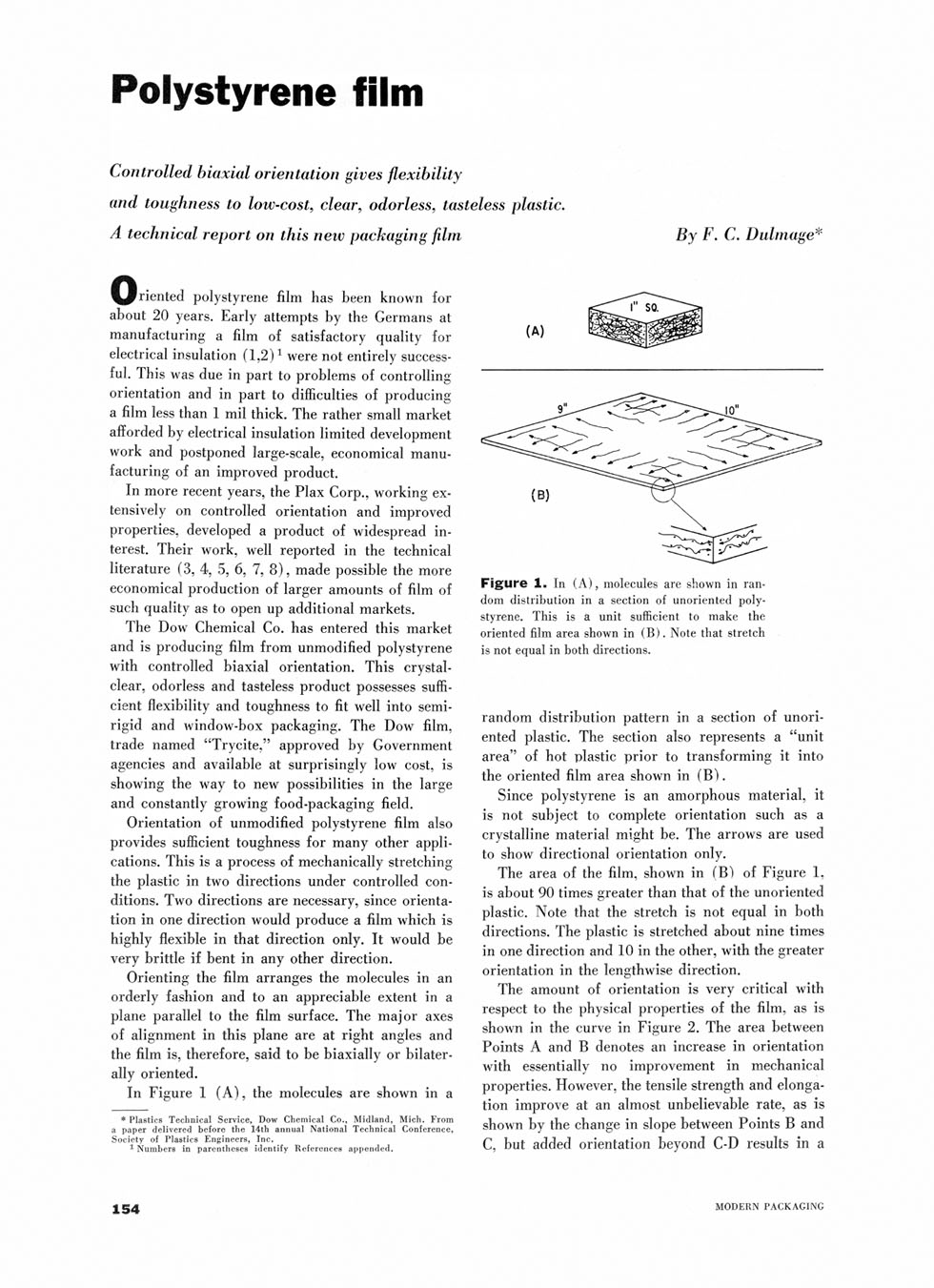


Polystyrene film
Controlled biaxial orientation gives flexibility
and toughness to low-cost, clear, odorless, tasteless plastic.
/I technical report on this new packaging film By F. C. Dulmage*
^Jriented polystyrene film has been known for about 20 years. Early attempts by the Germans at manufacturing a film of satisfactory quality for electrical insulation (1,2)* 1 were not entirely successful. This was due in part to problems of controlling orientation and in part to difficulties of producing a film less than 1 mil thick. The rather small market afforded by electrical insulation limited development work and postponed large-scale, economical manufacturing of an improved product.
In more recent years, the Plax Corp., working extensively on controlled orientation and improved properties, developed a product of widespread interest. Their work, well reported in the technical literature (3, 4, 5, 6, 7, 8), made possible the more economical production of larger amounts of film of such quality as to open up additional markets.
The Dow Chemical Co. has entered this market and is producing film from unmodified polystyrene with controlled biaxial orientation. This crystal-clear, odorless and tasteless product possesses sufficient flexibility and toughness to fit well into semirigid and window-box packaging. The Dow film, trade named "Trycite," approved by Government agencies and available at surprisingly low cost, is showing the way to new possibilities in the large and constantly growing food-packaging field.
Orientation of unmodified polystyrene film also provides sufficient toughness for many other applications. This is a process of mechanically stretching the plastic in two directions under controlled conditions. Two directions are necessary, since orientation in one direction would produce a film which is highly flexible in that direction only. It would be very brittle if bent in any other direction.
Orienting the film arranges the molecules in an orderly fashion and to an appreciable extent in a plane parallel to the film surface. The major axes of alignment in this plane are at right angles and the film is, therefore, said to be biaxially or bilaterally oriented.
In Figure 1 (A), the molecules are shown in a
* Plastics Technical Service, Dow Chemical Co., Midland, Mich. From a paper delivered before the 14th annual National Technical Conference, Society of Plastics Engineers, Inc.
1 Numbers in parentheses identify References appended.
so.
w lā K
Figure 1. In (A), molecules are shown in random distribution in a section of unoriented polystyrene. This is a unit sufficient to make the oriented film area shown in (B). Note that stretch is not equal in both directions.
random distribution pattern in a section of unoriented plastic. The section also represents a "unit area" of hot plastic prior to transforming it into the oriented film area shown in (B).
Since polystyrene is an amorphous material, it is not subject to complete orientation such as a crystalline material might be. The arrows are used to show directional orientation only.
The area of the film, shown in (B) of Figure 1, is about 90 times greater than that of the unoriented plastic. Note that the stretch is not equal in both directions. The plastic is stretched about nine times in one direction and 10 in the other, with the greater orientation in the lengthwise direction.
The amount of orientation is very critical with respect to the physical properties of the film, as is shown in the curve in Figure 2. The area between Points A and B denotes an increase in orientation with essentially no improvement in mechanical properties. However, the tensile strength and elongation improve at an almost unbelievable rate, as is shown by the change in slope between Points B and C, but added orientation beyond C-D results in a